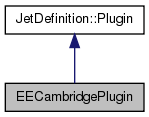EECambridgePlugin is a plugin for fastjet (v2.4 upwards) More...
#include <EECambridgePlugin.hh>


Public Member Functions | |
| EECambridgePlugin (double ycut) | |
| Main constructor for the EECambridge Plugin class. | |
| EECambridgePlugin (const EECambridgePlugin &plugin) | |
| copy constructor | |
| virtual std::string | description () const |
| return a textual description of the jet-definition implemented in this plugin | |
| virtual void | run_clustering (ClusterSequence &) const |
given a ClusterSequence that has been filled up with initial particles, the following function should fill up the rest of the ClusterSequence, using the following member functions of ClusterSequence:
| |
| double | ycut () const |
| virtual double | R () const |
| the plugin mechanism's standard way of accessing the jet radius. | |
| virtual bool | exclusive_sequence_meaningful () const |
| avoid the warning whenever the user requests "exclusive" jets from the cluster sequence | |
Private Attributes | |
| double | _ycut |
Detailed Description
EECambridgePlugin is a plugin for fastjet (v2.4 upwards)
It implements the Cambridge algorithm, as defined in
Better jet clustering algorithms Yuri Dokshitzer, Garth Leder, Stefano Moretti, Bryan Webber JHEP 9708 (1997) 001 http://www-spires.slac.stanford.edu/spires/find/hep/www?rawcmd=FIND+j+JHEPA%2C9708%2C001
On construction one must supply a ycut value.
To get the jets at the end call ClusterSequence::inclusive_jets();
Definition at line 57 of file EECambridgePlugin.hh.
Constructor & Destructor Documentation
| EECambridgePlugin::EECambridgePlugin | ( | double | ycut | ) | [inline] |
Main constructor for the EECambridge Plugin class.
It takes the dimensionless parameter ycut (the Q value for normalisation of the kt-distances is taken from the sum of all particle energies).
Definition at line 62 of file EECambridgePlugin.hh.
| EECambridgePlugin::EECambridgePlugin | ( | const EECambridgePlugin & | plugin | ) | [inline] |
Member Function Documentation
| string EECambridgePlugin::description | ( | ) | const [virtual] |
return a textual description of the jet-definition implemented in this plugin
Implements JetDefinition::Plugin.
Definition at line 71 of file EECambridgePlugin.cc.
{
ostringstream desc;
desc << "EECambridge plugin with ycut = " << ycut() ;
return desc.str();
}
| virtual bool EECambridgePlugin::exclusive_sequence_meaningful | ( | ) | const [inline, virtual] |
avoid the warning whenever the user requests "exclusive" jets from the cluster sequence
Reimplemented from JetDefinition::Plugin.
Definition at line 82 of file EECambridgePlugin.hh.
{return true;}
| virtual double EECambridgePlugin::R | ( | ) | const [inline, virtual] |
the plugin mechanism's standard way of accessing the jet radius.
This must be set to return something sensible, even if R does not make sense for this algorithm!
Implements JetDefinition::Plugin.
Definition at line 78 of file EECambridgePlugin.hh.
{return 1.0;}
| void EECambridgePlugin::run_clustering | ( | ClusterSequence & | ) | const [virtual] |
given a ClusterSequence that has been filled up with initial particles, the following function should fill up the rest of the ClusterSequence, using the following member functions of ClusterSequence:
- plugin_do_ij_recombination(...)
- plugin_do_iB_recombination(...)
Implements JetDefinition::Plugin.
Definition at line 77 of file EECambridgePlugin.cc.
References ClusterSequence::jets(), d0::inline_maths::min(), ClusterSequence::plugin_record_iB_recombination(), ClusterSequence::plugin_record_ij_recombination(), and ClusterSequence::Q2().
{
int njets = cs.jets().size();
NNH<EECamBriefJet> nnh(cs.jets());
double Q2 = cs.Q2();
while (njets > 0) {
int i, j, k;
// here we get a minimum based on the purely angular variable from the NNH class
// (called dij there, but vij in the Cambridge article (which uses dij for
// a kt distance...)
double vij = nnh.dij_min(i, j); // i,j are return values...
// next we work out the dij (ee kt distance), and based on its
// value decide whether we have soft-freezing (represented here by
// a "Beam" clustering) or not
double dij;
if (j >= 0) {
double scale = min(cs.jets()[i].E(), cs.jets()[j].E());
dij = 2 * vij * scale * scale;
if (dij > Q2 * ycut()) {
// we'll call the softer partner a "beam" jet
if (cs.jets()[i].E() > cs.jets()[j].E()) swap(i,j);
j = -1;
}
} else {
// for the last particle left, just use yij = 1
dij = Q2;
}
if (j >= 0) {
cs.plugin_record_ij_recombination(i, j, dij, k);
nnh.merge_jets(i, j, cs.jets()[k], k);
} else {
cs.plugin_record_iB_recombination(i, dij);
nnh.remove_jet(i);
}
njets--;
}
}
| double EECambridgePlugin::ycut | ( | ) | const [inline] |
Member Data Documentation
double EECambridgePlugin::_ycut [private] |
Definition at line 85 of file EECambridgePlugin.hh.
Referenced by ycut().
The documentation for this class was generated from the following files:
- plugins/EECambridge/fastjet/EECambridgePlugin.hh
- plugins/EECambridge/EECambridgePlugin.cc
 1.7.3
1.7.3